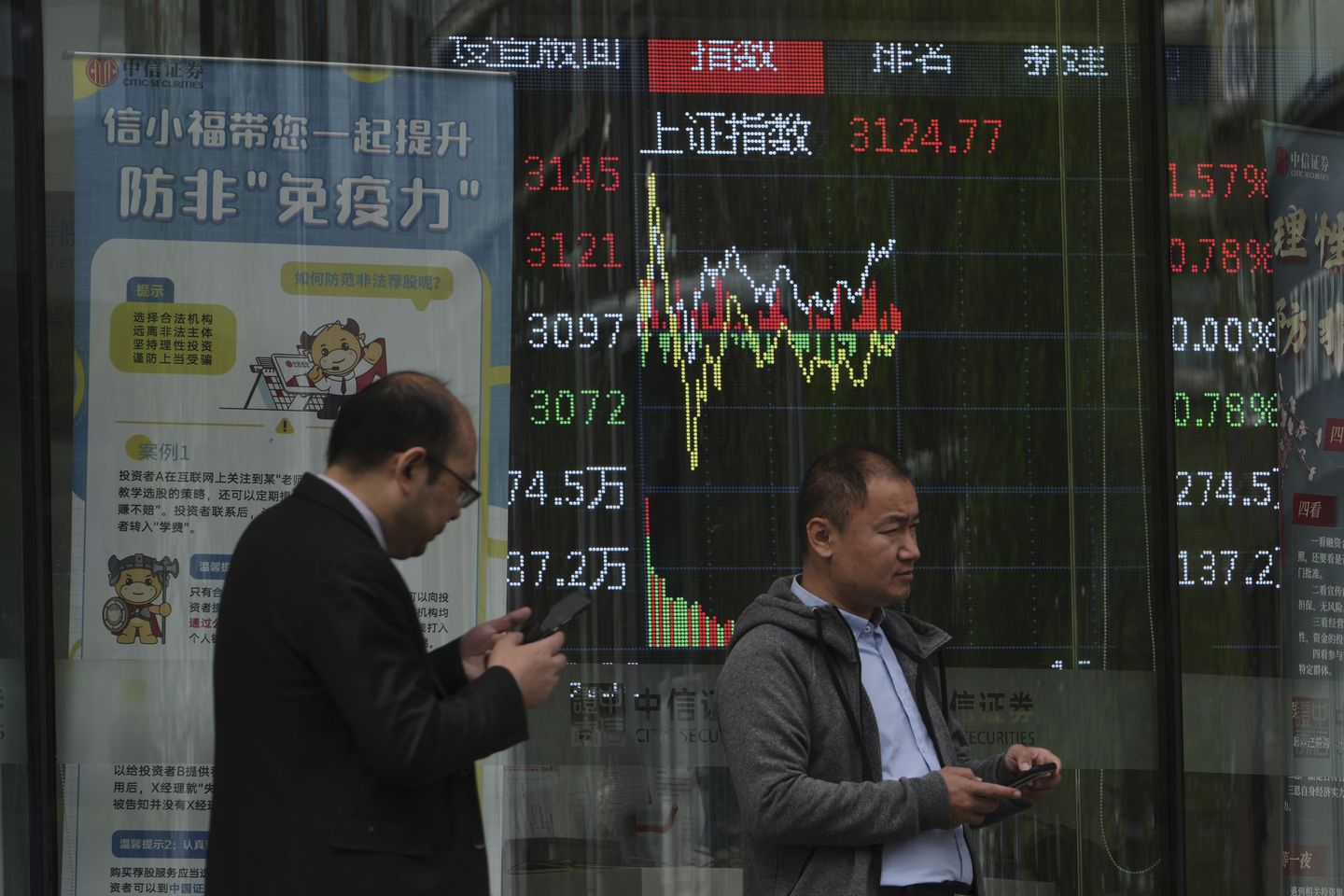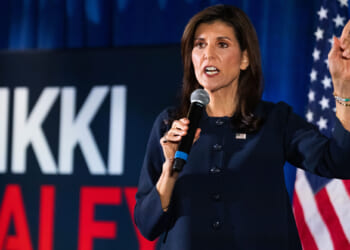
President Trump will not pause or postpone hefty tariffs that target dozens of countries, and massive new levies on China will take effect at midnight Tuesday, the White House said, sending global markets and negotiations into uncertain territory.
Mr. Trump’s blanket 10% tariff on all imports went into effect over the weekend. But larger levies against Asian and Latin trading partners, European allies and small African and island nations will start to bite on Wednesday.
“He’s not considering an extension or a delay,” White House press secretary Karoline Leavitt said. “He expects that these tariffs are going to go into effect.”
Ms. Leavitt also confirmed that a 50% increase in tariffs on China will go into effect, as Mr. Trump threatened on Monday. The new tariffs will bring the tariff rate on China to 104%.
“They will be going into effect at 12:01 a.m.,” Ms. Leavitt said at her regular briefing on Tuesday.
Wall Street stocks rebounded early Tuesday after a multi-day selloff over the aggressive trade plan, buoyed by talk of bilateral deals with individual countries to reduce trade barriers. However, market gains evaporated as the day progressed.
SEE ALSO: China says it ‘will not flinch’ in trade fight with U.S.
The administration said dozens of countries are looking to negotiate down trade barriers on the U.S., even as Beijing vowed to fight “to the end” against Mr. Trump’s plan.
Mr. Trump said he had a “great call” Tuesday with Han Duck-soo, acting president of South Korea. He said China “also wants to make a deal, badly, but they don’t know how to get it started.”
“We are waiting for their call,” he said on Truth Social. “It will happen!”
Ms. Leavitt said the entire White House trade team is on board with Mr. Trump’s plan and defended its focus on trade deficits. Trade deficits arise when the U.S. buys far more products from a country compared to what that nation buys from U.S. producers.
Some business leaders and Republicans who support Mr. Trump have questioned the underpinning of the White House’s use of trade deficits to set tariff rates, though the White House is standing by the formula.
“To countries around the world, bring us your best offers, and [the president] will listen. Deals will only be made if they benefit American workers and address our nation’s crippling trade deficits,” Ms. Leavitt said. “America does not need other countries as much as other countries need us. And President Trump knows this.”
She also offered a warning to China.
“President Trump has a spine of steel,” she said, “and he will not break.”
U.S. Trade Representative Jamieson Greer echoed that message on Capitol Hill, telling lawmakers that Mr. Trump is making progress in opening up foreign markets for U.S. producers.
“We must move away from an economy that’s based solely on government spending and the financial sector, and we must become an economy based on producing real goods and services that provide jobs for middle-class Americans and their communities,” Mr. Greer told the Senate Finance Committee. “This adjustment may be challenging at times. In a moment of drastic overdue change, I’m certain the American people can rise to the challenge as they’ve done before.”
Mr. Greer took the hot seat on Capitol Hill as global markets and leaders tried to unpack the fallout of Mr. Trump’s “Liberation Day” announcement last week.
The breadth and mathematical basis for Mr. Trump’s tariff calculations caught some investors, including his supporters, off guard, and European allies said they are prepared to retaliate if negotiations fail.
“We are mourning the United States that we knew,” Stephane Boujnah, the CEO of the Euronext stock exchange, told France Inter radio. “Now it looks more like an emerging country.”
Italian Prime Minister Giorgia Meloni is scheduled to visit Mr. Trump at the White House on April 17. She’ll have an opportunity for her to speak about trade on behalf of Italy and Europe.
Mr. Trump and Ms. Meloni have had a good relationship, but Italy was not spared from the Trump tariff plan, facing a general 20% tariff along with other E.U. countries.
She said the tariffs were “wrong” but that she would work to avoid a “trade war.”
Beijing’s Foreign Ministry reacted harshly to Mr. Trump’s threat to impose an additional 50% tariff on Chinese goods on Wednesday, a move that would bring China’s tariff rate to 104%.
“We Chinese are not troublemakers, but we will not flinch when trouble comes our way. Intimidation, threats and blackmail are not the right way to engage with China,” ministry spokesman Lin Jian said. “If the U.S. decides not to care about the interests of the U.S. itself, China and the rest of the world, and is determined to fight a tariff and trade war, China’s response will continue to the end.”
Even congressional Republicans who are generally supportive of Mr. Trump’s plans questioned aspects of the tariff strategy.
Sen. Ron Johnson, Wisconsin Republican, told Mr. Greer he was worried about the lack of exemptions for certain products or industries.
“Tariffs are a double-edged sword,” he said. “I hope you and the president are sensitive to companies potentially going bankrupt by these actions.”
Sen. Thom Tillis, North Carolina Republican, was more direct.
“Whose throat do I get to choke if this proves to be wrong?” Mr. Tillis said.
Democrats said they would force a Senate vote on a resolution that would revoke Mr. Trump’s power to impose the reciprocal tariffs. Even if it passes, the measure is unlikely to get traction in the House.
“This is a call to action,” Mr. Wyden said. “Congress must step in to rein in this president on trade.”
Mr. Wyden said Americans are watching their retirement savings fall with U.S. stocks, and it is unclear what Mr. Trump’s tariffs are supposed to accomplish. White House officials are pointing to higher revenue from tariffs, while saying the goal is to bring jobs back to the U.S., which would ultimately decrease tariff revenue.
“What is the plan? In the last week, the White House has been all over the map when it comes to this question,” Mr. Wyden said.
Tariffs are a tax or duty paid by importers on the goods they bring in from foreign markets. Importers of record, typically U.S. companies, pay the tariffs and sometimes pass along the costs to consumers through higher prices.
For years, Mr. Trump has promoted tariffs as a way to gain leverage in trade deals. He is laser-focused on trade imbalances with other countries, in which the U.S. buys more goods from a trade partner than it sells to that country.
Mr. Greer defended Mr. Trump’s focus on trade imbalances, saying they made the U.S. too reliant, for instance, on foreigners for military equipment and pharmaceuticals. He said European nations send shellfish to American consumers all the time, yet ban similar exports from most U.S. states.
He said Mr. Trump’s auto tariffs are producing results, citing automakers who aren’t cutting production and a bevy of nations that came forward to strike trade deals.
Some Republicans said they were optimistic about efforts to level the playing field. But they said countries like Vietnam, which was hard-hit by Mr. Trump’s tariffs, can buy only so much from Americans.
“Bringing down trade barriers would be helpful so that they would accept American products to be sold there,” Sen. James Lankford, Oklahoma Republican, said. “Most countries in the world are never going to buy as much as we’re purchasing because we just purchase a lot more from there.”
Sen. Mark Warner, Virginia Democrat, said the U.S. has a trade surplus with Australia and a free-trade agreement, so he wasn’t sure why they faced a 10% tariff.
“They are an incredibly important national security partner. Why were they whacked with a tariff?” Mr. Warner said.
Mr. Greer said the U.S. should be “running up the score” with Australia and said the country bans U.S. pork and beef. He repeated Mr. Trump’s belief that the U.S. must reduce its global trade deficit.
“You’re a much smarter person than that answer,” Mr. Warner said. “We’re looking like an economy that will be in hospice.”












